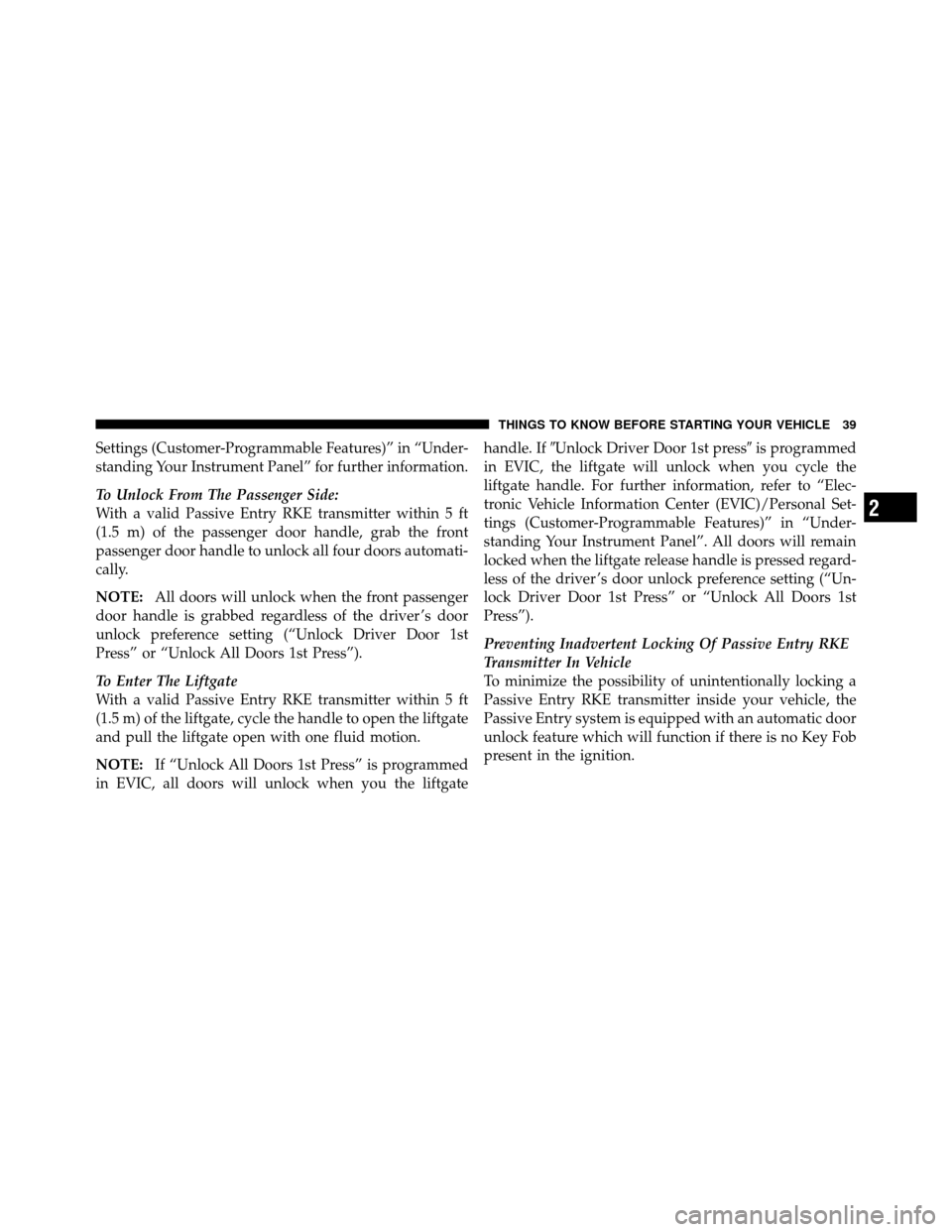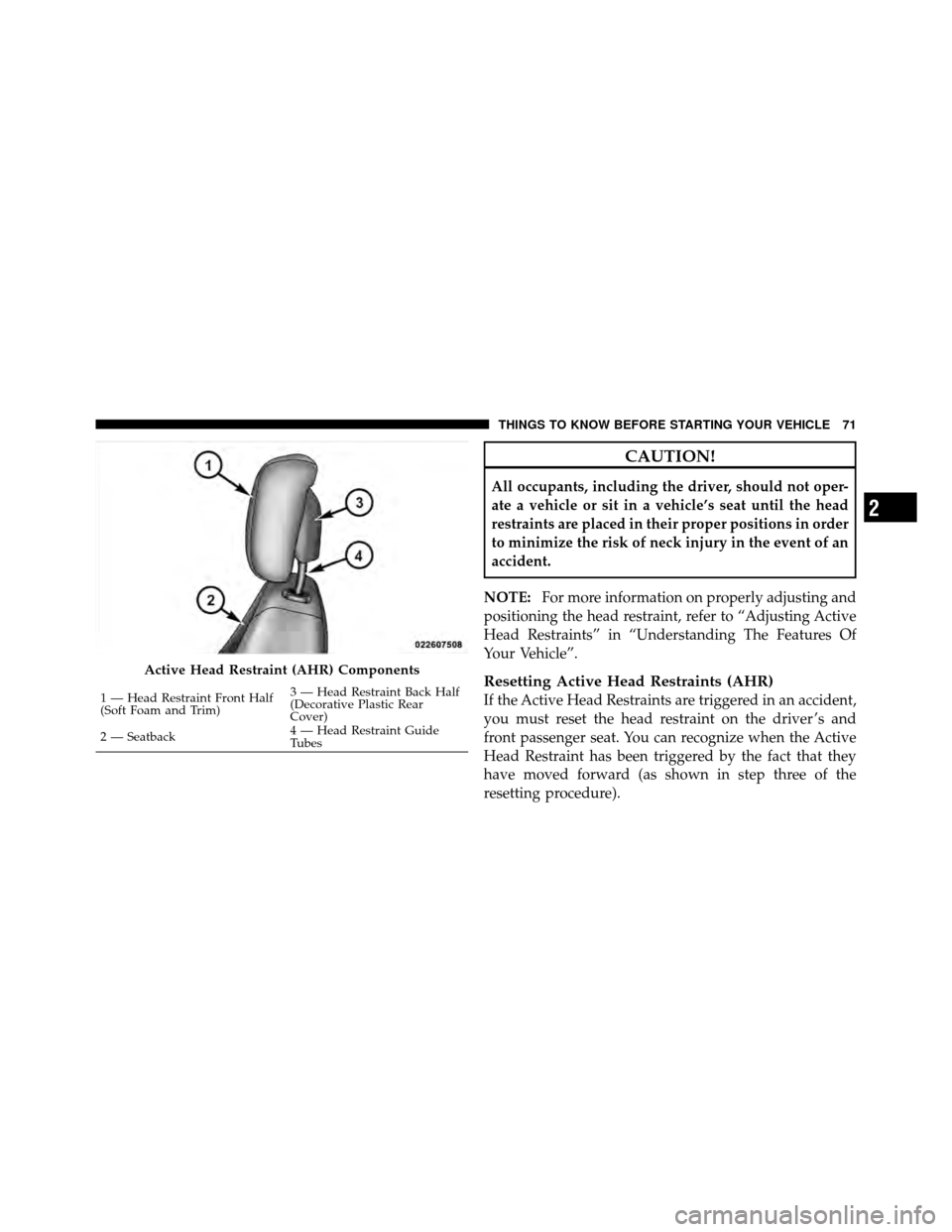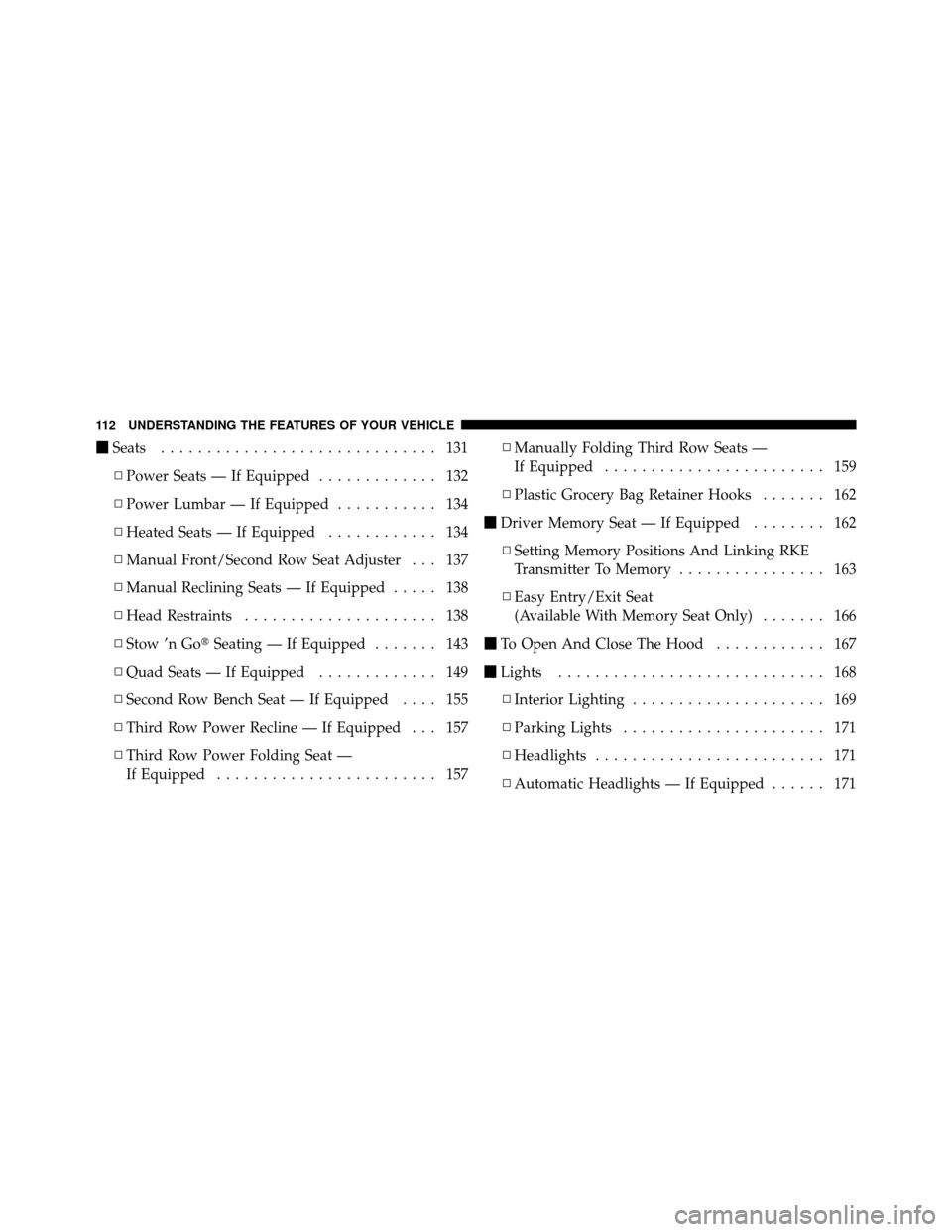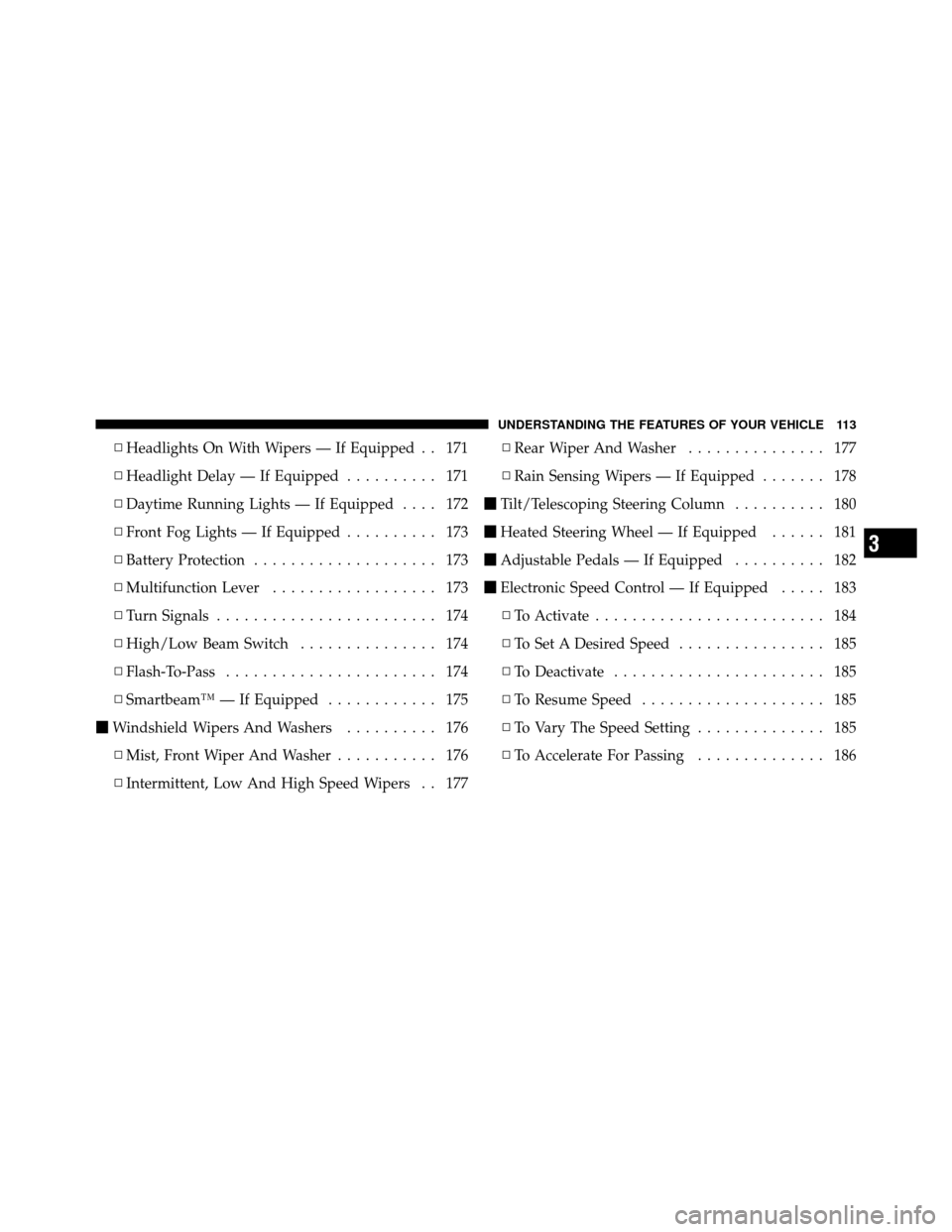Page 42 of 573

Settings (Customer-Programmable Features)” in “Under-
standing Your Instrument Panel” for further information.
To Unlock From The Passenger Side:
With a valid Passive Entry RKE transmitter within 5 ft
(1.5 m) of the passenger door handle, grab the front
passenger door handle to unlock all four doors automati-
cally.
NOTE:All doors will unlock when the front passenger
door handle is grabbed regardless of the driver ’s door
unlock preference setting (“Unlock Driver Door 1st
Press” or “Unlock All Doors 1st Press”).
To Enter The Liftgate
With a valid Passive Entry RKE transmitter within 5 ft
(1.5 m) of the liftgate, cycle the handle to open the liftgate
and pull the liftgate open with one fluid motion.
NOTE: If “Unlock All Doors 1st Press” is programmed
in EVIC, all doors will unlock when you the liftgate handle. If
�Unlock Driver Door 1st press� is programmed
in EVIC, the liftgate will unlock when you cycle the
liftgate handle. For further information, refer to “Elec-
tronic Vehicle Information Center (EVIC)/Personal Set-
tings (Customer-Programmable Features)” in “Under-
standing Your Instrument Panel”. All doors will remain
locked when the liftgate release handle is pressed regard-
less of the driver ’s door unlock preference setting (“Un-
lock Driver Door 1st Press” or “Unlock All Doors 1st
Press”).
Preventing Inadvertent Locking Of Passive Entry RKE
Transmitter In Vehicle
To minimize the possibility of unintentionally locking a
Passive Entry RKE transmitter inside your vehicle, the
Passive Entry system is equipped with an automatic door
unlock feature which will function if there is no Key Fob
present in the ignition.
2
THINGS TO KNOW BEFORE STARTING YOUR VEHICLE 39
Page 60 of 573

•If the power liftgate encounters multiple obstructions
within the same cycle, the system will automatically
stop and must be opened or closed manually.
WARNING!
•Driving with the liftgate open can allow poison-
ous exhaust gases into your vehicle. You and your
passengers could be injured by these fumes. Keep
the liftgate closed when you are operating the
vehicle.
•If you are required to drive with the liftgate open,
make sure that all windows are closed, and the
climate control blower switch is set at high speed.
Do not use the recirculation mode.
Gas props support the liftgate in the open position.
However, because the gas pressure drops with tempera-
ture, it may be necessary to assist the props when
opening the liftgate in cold weather.
OCCUPANT RESTRAINTS
Some of the most important safety features in your
vehicle are the restraint systems:
•Three-point lap and shoulder belts for all seating
positions
•Advanced Front Air Bags for driver and front passen-
ger
•Supplemental Active Head Restraints (AHR) located
on top of the front seats (integrated into the head
restraint) — if equipped
•Supplemental Driver Side Knee Air Bag
•Supplemental Side Air Bag Inflatable Curtains
(SABIC) that span the front, second, and third row
seating for the driver and passengers seated next to a
window
•Supplemental Seat-Mounted Side Air Bags (SAB)
2
THINGS TO KNOW BEFORE STARTING YOUR VEHICLE 57
Page 74 of 573

CAUTION!
All occupants, including the driver, should not oper-
ate a vehicle or sit in a vehicle’s seat until the head
restraints are placed in their proper positions in order
to minimize the risk of neck injury in the event of an
accident.
NOTE: For more information on properly adjusting and
positioning the head restraint, refer to “Adjusting Active
Head Restraints” in “Understanding The Features Of
Your Vehicle”.
Resetting Active Head Restraints (AHR)
If the Active Head Restraints are triggered in an accident,
you must reset the head restraint on the driver ’s and
front passenger seat. You can recognize when the Active
Head Restraint has been triggered by the fact that they
have moved forward (as shown in step three of the
resetting procedure).
Active Head Restraint (AHR) Components
1 — Head Restraint Front Half
(Soft Foam and Trim) 3 — Head Restraint Back Half
(Decorative Plastic Rear
Cover)
2 — Seatback 4 — Head Restraint Guide
Tubes
2
THINGS TO KNOW BEFORE STARTING YOUR VEHICLE 71
Page 82 of 573

Advanced Front Air Bag Features
The Advanced Front Air Bag system has multistage
driver and front passenger air bags. This system provides
output appropriate to the severity and type of collision as
determined by the Occupant Restraint Controller (ORC),
which may receive information from the front impact
sensors.
The first stage inflator is triggered immediately during an
impact that requires air bag deployment. This low output
is used in less severe collisions. A higher energy output is
used for more severe collisions.WARNING!
•No objects should be placed over or near the air
bag on the instrument panel, because any such
objects could cause harm if the vehicle is in a
collision severe enough to cause the air bag to
inflate.
•Do not put anything on or around the air bag
covers or attempt to open them manually. You may
damage the air bags and you could be injured
because the air bags may no longer be functional.
The protective covers for the air bag cushions are
designed to open only when the air bags are
inflating.
•Do not drill, cut or tamper with the knee bolster in
any way.
•Do not mount any accessories to the knee bolster
such as alarm lights, stereos, citizen band radios,
etc.
2
THINGS TO KNOW BEFORE STARTING YOUR VEHICLE 79
Page 83 of 573

Supplemental Seat-Mounted Side Air Bags (SAB)
Supplemental Seat-Mounted Side Air Bags may provide
enhanced protection to help protect an occupant during a
side impact. The Supplemental Seat-Mounted Side Air
Bag is marked with an air bag label sewn into the
outboard side of the front seats.When the air bag deploys, it opens the seam between the
front and side of the seat’s trim cover. Each air bag
deploys independently; a left side impact deploys the left
air bag only and a right-side impact deploys the right air
bag only.
Supplemental Side Air Bag Inflatable Curtain
(SABIC)
SABIC air bags may offer side-impact and vehicle roll-
over protection to front and rear seat outboard occupants
in addition to that provided by the body structure. Each
air bag features inflated chambers placed adjacent to the
head of each outboard occupant that reduce the potential
for side-impact head injuries. The curtains deploy down-
ward, covering both windows on the impact side.
NOTE:
•Should a vehicle rollover occur, the pretensioners
and/or SAB and SABIC air bags on both sides of the
vehicle may deploy.
Supplemental Seat-Mounted Side Air Bag Label
80 THINGS TO KNOW BEFORE STARTING YOUR VEHICLE
Page 114 of 573
UNDERSTANDING THE FEATURES OF YOUR VEHICLE
CONTENTS
�Mirrors ............................. 117
▫ Inside Day/Night Mirror — If Equipped . . . 117
▫ Automatic Dimming Mirror — If Equipped . . 118
▫ Outside Mirrors ..................... 118
▫ Driver’s Automatic Dimming Mirror —
If Equipped ........................ 119
▫ Outside Mirror Folding Feature .......... 119
▫ Power Mirrors — If Equipped ........... 119
▫ Heated Mirrors — If Equipped ........... 120▫
Tilt Mirrors In Reverse (Available With
Memory Seat Only) — If Equipped ........ 120
▫ Power Folding Mirrors — If Equipped ..... 121
▫ Illuminated Vanity Mirrors — If Equipped . . 121
� Blind Spot Monitoring — If Equipped ....... 122
▫ Rear Cross Path ..................... 128
▫ Modes Of Operation .................. 129
� Uconnect™ Phone — If Equipped .......... 130
� Voice Command — If Equipped ........... 131
3
Page 115 of 573

�Seats .............................. 131
▫ Power Seats — If Equipped ............. 132
▫ Power Lumbar — If Equipped ........... 134
▫ Heated Seats — If Equipped ............ 134
▫ Manual Front/Second Row Seat Adjuster . . . 137
▫ Manual Reclining Seats — If Equipped ..... 138
▫ Head Restraints ..................... 138
▫ Stow ’n Go� Seating — If Equipped ....... 143
▫ Quad Seats — If Equipped ............. 149
▫ Second Row Bench Seat — If Equipped .... 155
▫ Third Row Power Recline — If Equipped . . . 157
▫ Third Row Power Folding Seat —
If Equipped ........................ 157 ▫
Manually Folding Third Row Seats —
If Equipped ........................ 159
▫ Plastic Grocery Bag Retainer Hooks ....... 162
� Driver Memory Seat — If Equipped ........ 162
▫ Setting Memory Positions And Linking RKE
Transmitter To Memory ................ 163
▫ Easy Entry/Exit Seat
(Available With Memory Seat Only) ....... 166
� To Open And Close The Hood ............ 167
� Lights ............................. 168
▫ Interior Lighting ..................... 169
▫ Parking Lights ...................... 171
▫ Headlights ......................... 171
▫ Automatic Headlights — If Equipped ...... 171
112 UNDERSTANDING THE FEATURES OF YOUR VEHICLE
Page 116 of 573

▫Headlights On With Wipers — If Equipped . . 171
▫ Headlight Delay — If Equipped .......... 171
▫ Daytime Running Lights — If Equipped .... 172
▫ Front Fog Lights — If Equipped .......... 173
▫ Battery Protection .................... 173
▫ Multifunction Lever .................. 173
▫ Turn Signals ........................ 174
▫ High/Low Beam Switch ............... 174
▫ Flash-To-Pass ....................... 174
▫ Smartbeam™ — If Equipped ............ 175
� Windshield Wipers And Washers .......... 176
▫ Mist, Front Wiper And Washer ........... 176
▫ Intermittent, Low And High Speed Wipers . . 177 ▫
Rear Wiper And Washer ............... 177
▫ Rain Sensing Wipers — If Equipped ....... 178
� Tilt/Telescoping Steering Column .......... 180
� Heated Steering Wheel — If Equipped ...... 181
� Adjustable Pedals — If Equipped .......... 182
� Electronic Speed Control — If Equipped ..... 183
▫ To Activate ......................... 184
▫ To Set A Desired Speed ................ 185
▫ To Deactivate ....................... 185
▫ To Resume Speed .................... 185
▫ To Vary The Speed Setting .............. 185
▫ To Accelerate For Passing .............. 186
3
UNDERSTANDING THE FEATURES OF YOUR VEHICLE 113